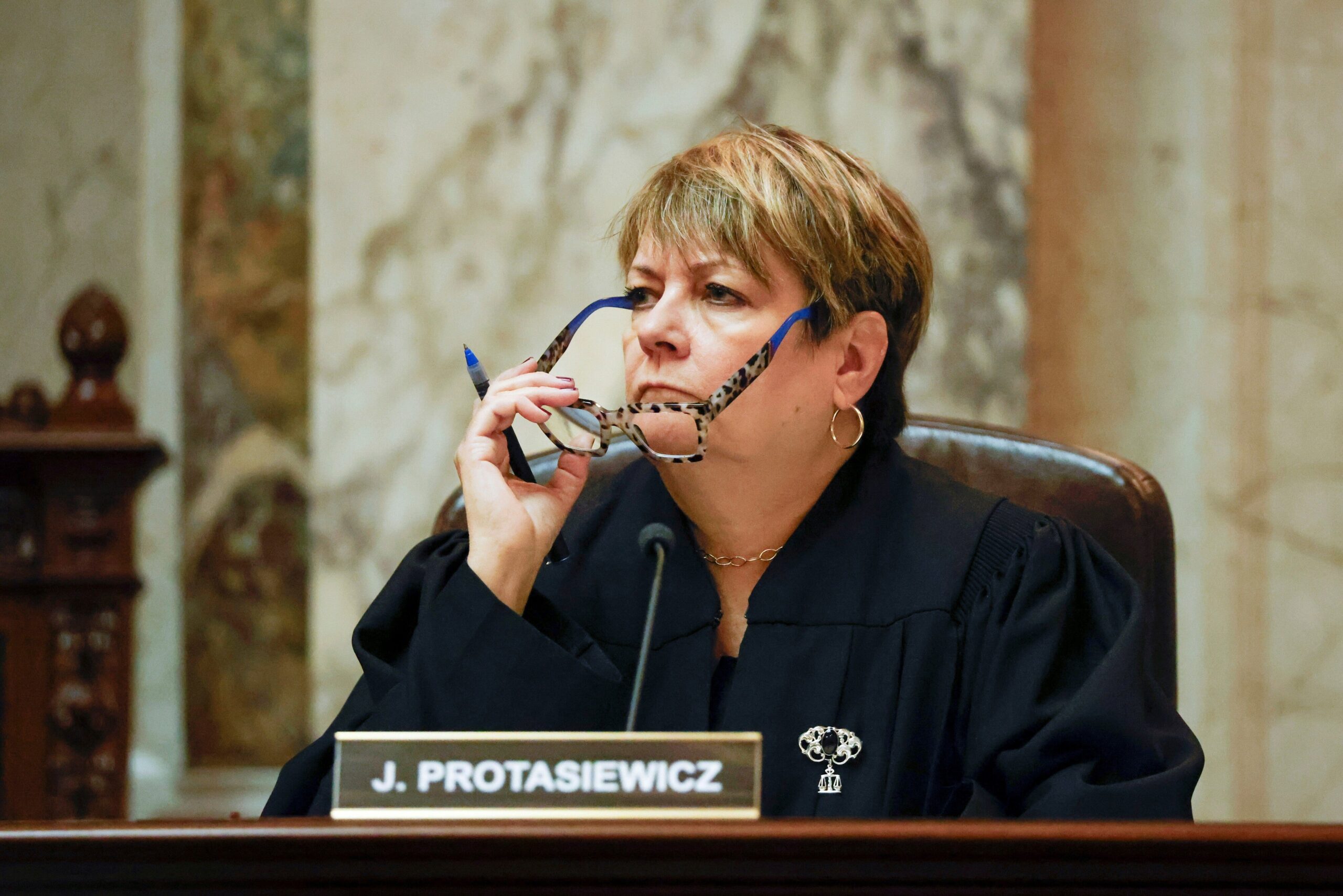Gov. Tony Evers has signed new legislative maps into law, potentially loosening the GOP grip on power in Wisconsin state government for the first time in well over a decade.
Evers’ signature effectively ends a years-long fight by Democrats to rebalance the political playing field in Wisconsin, where Republican-drawn maps have cemented lopsided GOP majorities in a state that otherwise has a penchant for close elections.
It also likely ends the months-long redistricting lawsuit before the Wisconsin Supreme Court that teed up these maps. The court’s 4-3 liberal majority struck down the current district lines in December and was laying the groundwork to draw new maps if Evers and the Legislature couldn’t do it first.
Stay informed on the latest news
Sign up for WPR’s email newsletter.
Surprisingly, they did. The new maps passed by the Legislature and signed by Evers are identical to those the governor submitted to the court as one of six options to replace the Republican-drawn districts. Redistricting experts hired by the court’s liberal majority say the governor’s maps have a slight Republican tilt but are competitive enough that “the party that wins the most votes will win the most seats” in the state Legislature.
In a social media post, Evers said, “When I promised I wanted fair maps — not maps that are better for one party or another — I damn well meant it.”
“The people should get to choose their elected officials, not the other way around,” Evers said. “And under the maps I’m signing today, I am making good on that promise.”
During a press conference at the Wisconsin Capitol, Evers acknowledged there were some in his own party who wanted him to veto the maps and leave redistricting in the court’s hands.
“That’s the great thing about democracy, folks,” Evers said, “Sometimes people have different opinions on various things and I just accept that. My goal is to make sure that the will of the people is the law of the land.”
Unlikely bipartisan alliance led to Evers’ maps becoming law
In a remarkable about face, Evers’ maps were introduced last week by Republican lawmakers who had argued against them in court weeks before. The maps passed both houses within hours without any public hearing.
Just before the state Senate voted on the maps, Senate Majority Leader Devin LeMahieu, R-Oostburg, said “the writing was on the wall” with the court, telling colleagues their only options were either to pass the governor’s maps or “allow the liberal majority to gerrymander the state at the very last minute without public input.”
Ahead of the Assembly vote, Speaker Robin Vos, R-Rochester, called it “a huge win” for Evers and said he believes the GOP can be competitive under the maps but conceded “the Legislature will be up for grabs.”
In an equally notable turn, all but two Democratic lawmakers voted against Evers maps, with some claiming the GOP embrace is a “trojan horse” that could set up future legal challenges. Those lawmakers stopped short of calling on Evers to veto the plans, but several said the court’s liberal majority should be allowed to conclude an ongoing redistricting lawsuit by choosing new maps instead.
At the same time, groups that have long decried gerrymandering in Wisconsin encouraged Evers to sign his maps into law. In a statement, those groups said that despite concerns surrounding the process used by Republicans, it has “created an opportunity for real change” that will make Wisconsin’s “democracy stronger and more inclusive.”
In a statement Monday, Vos said Republicans are “happy that the Governor’s signature brings to an end decades of liberal special interest litigation over maps in Wisconsin.”
“Today, Governor Evers signed the most Republican-leaning maps out of all the Democrat-gerrymandered maps being considered by the Wisconsin Supreme Court,” Vos said. “This fall Republicans will prove that we can win on any maps because we have the better policy ideas for the State of Wisconsin.”

Unanswered questions remain going into 2024 elections
While a governor’s signature may seem like the final piece of the state’s redistricting puzzle, there are still questions about what districts lawmakers might run in between now and the November general election.
A line included at the end of the 165-page bill specifies the maps will go into effect for all elections in November, but won’t apply to “special or recall elections” held before then.
Democratic state senators, who got their first look at the legislation just before the Senate voted, accused Republicans last week of including the exception to guarantee Vos can run under his old district in a potential recall election. That contest is being pursued by conservatives who are angry he’s stood in the way of impeaching Wisconsin Elections Commission Administrator Meagan Wolfe.
But that effective date was added to the maps bill by the Legislative Reference Bureau, not Republican lawmakers. A bureau memo said the addition “is our standard practice for addressing the initial applicability of a legislative redistricting plan.”
University of Wisconsin-Madison Associate Professor of Law Robert Yablon, who signed onto a legal brief in the redistricting case, told WPR it’s “an open question” as to which maps should apply between now and the November election.
“So, if an early election needed to be held, the likelihood is that someone would need to go back to the Wisconsin Supreme Court and ask what map would be applied,” Yablon said. “And the Wisconsin Supreme Court would need to provide some kind of guidance or remedy.”
Yablon said that because the court has already declared the existing Republican-drawn districts illegal, “it will have to be another map, perhaps the Governor’s map,” even though that map doesn’t go into effect until the fall.
On Monday, Evers said he will ask the court “to clarify that these maps will be in place for any special elections between now and the fall.”

The road to redistricting
There’s been no shortage of twists and turns in Wisconsin’s latest redistricting battle, which started with a lawsuit filed the day after the Wisconsin Supreme Court flipped to liberal control for the first time in 15 years.
The suit, filed by a group of Democratic voters represented by liberal law firm Law Forward, argued Republican-drawn districts enacted in 2022 by the Supreme Court’s then-conservative majority were “extreme partisan gerrymanders” that violated multiple provisions in the Wisconsin Constitution. They claimed the maps violated Democrats’ equal protection guarantee and the constitution’s promises of free speech and assembly.
When it agreed to take the case, the court’s liberal majority decided against ruling on the gerrymandering claims and instead focused on two claims, which included an argument that the Republican maps violated the Wisconsin Constitution’s contiguity requirement because dozens of districts include detached pieces.
In response, Republican lawmakers demanded newly sworn Justice Janet Protasiewicz recuse herself from the case because of comments she made on the campaign trail calling the GOP maps “rigged” and saying there needs to be “a fresh look at the gerrymandering question.” When Protasiewicz refused to step aside, it amplified calls from some Republicans that she should be impeached.
Vos had also said the U.S. Supreme Court “will have the last word” on the matter.

On Dec. 22, the court ruled the Republican maps did violate the constitution’s contiguity requirement. The liberal majority asked parties in the case to submit new map proposals that addressed constitutional requirements while also taking “partisan impact” into account.
The court hired University of California, Irvine political scientist Bernard Grofman and Carnegie Mellon University political scientist Jonathan Cervas to evaluate map proposals from the Republican-controlled Legislature; Gov. Evers; Republican voters represented by the conservative Wisconsin Institute for Law and Liberty, or WILL; Democrats who filed the suit; Democratic state senators; and a group of academics. Their analysis called maps from the Legislature and WILL gerrymanders and said any of the four remaining proposals would be far more competitive than what the court struck down.
The December ruling called on the Legislature and Evers to agree to maps but said the court would enact new maps if there was an impasse.
Republicans initially passed a version of Evers’ maps with a handful of changes to protect GOP incumbents, but the governor vetoed the plan, calling it gerrymandering. Weeks later, Republicans passed Evers’ identical maps, which the governor signed Monday morning.
Another lawsuit challenging GOP-drawn congressional districts awaits
As one Wisconsin redistricting saga draws to a close, another could be just beginning.
While the new maps signed by Evers apply to the state Assembly and state Senate districts, a new lawsuit filed by a high-profile Democratic law firm is challenging Wisconsin’s eight congressional districts. Six of those are held by Republicans.
The congressional lawsuit hinges on a finding by justices in the legislative redistricting case, where the liberal majority rejected the “least changes” rationale used by the court’s conservative majority just two years earlier. Under that approach, the court’s conservatives chose both legislative and congressional maps that were similar to the ones Republicans drew in 2011 when they controlled all branches of state government following an historic wave election.
In December, the new liberal majority ruled that the “least changes” had no basis in state law or the constitution, overruling it entirely. The court has yet to decide whether it will hear the congressional case.
The new legislative maps could also face their own lawsuit — potentially in federal court — on a different set of issues, including the number of voters who will have to wait an extra two years to vote in a race for state Senate. But both Democrats and Republicans have said such a challenge would face an uphill climb, and that judges would be reluctant to overturn a map passed by a Republican Legislature and signed into law by a Democratic governor.
A statement from state Rep. LaKeshia Myers, D-Milwaukee, called the new maps a victory, but said she is disappointed that the legislative process will “silence the Wisconsin Supreme Court and kill any decision it could possibly make.”
“The map signed today is still not truly ‘fair’. There are concerns regarding the Voting Rights Act and how communities of like-interest are impacted, especially in Senate District 4, “Myers said.
Myers, who is running in a special election for the 4th Senate District, said it was her hope that a court would take these issues into consideration, saying anything else would be a disservice to the African American voters who live in the district.
The Wisconsin Legislative Black Caucus issued a statement saying its members have concerns the map violates the VRA. The caucus is chaired by state Rep. Dora Drake, D-Milwaukee, who is also running for the 4th Senate District seat.
“We will be seeking additional experts and input to confirm if this map upholds the Voting Rights Act and move accordingly,” said the statement. “All of our communities deserve maps that are fair and deserve maps where all communities can choose their candidate of choice.”
The redistricting experts who were hired by the court found no Voting Rights Act issues with Evers maps.
For more on the history of redistricting in Wisconsin and how it impacts political power in the state, check out WPR’s investigative podcast series, “Mapped Out.”
Wisconsin Public Radio, © Copyright 2025, Board of Regents of the University of Wisconsin System and Wisconsin Educational Communications Board.





